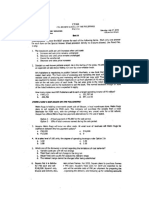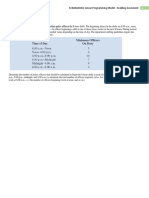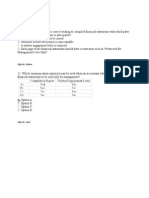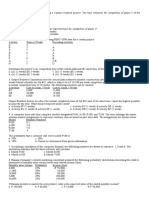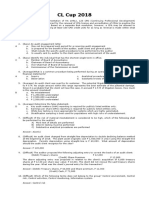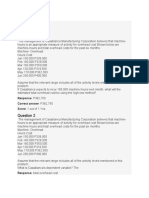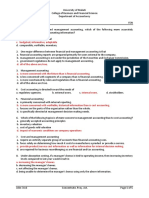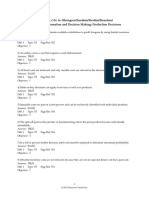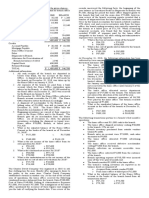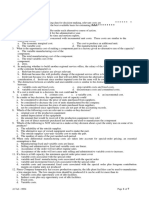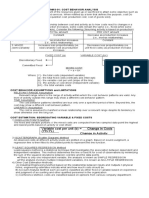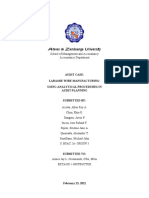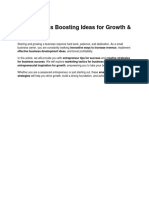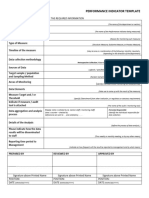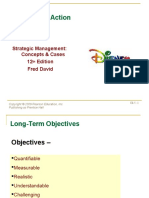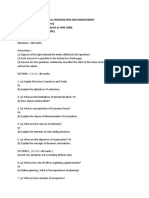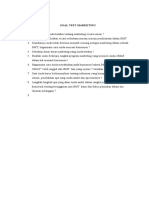DEPARTMENT OF ACCOUNTANCY
REFRESHER COURSE
MSU-Marawi City
COST CONCEPTS AND ANALYSIS Management Advisory Services
COST – a monetary measure of the amount of the resources given up to attain some objective such as acquiring goods and services. When
notified by a term that defines the purpose, cost becomes operational.
COST CLASSIFICATIONS
As to time of occurrence As to types of inventory
Sunk/Historical cost (past) Raw materials inventory
Replacement cost (present) Work-in-process inventory
Budgeted cost (future) Finished goods inventory
As to time-frame perspective As to usage in planning and control
Committed cost (consequence) Budgeted cost (planning)
Discretionary cost (avoidable) Standard cost (controlling)
As to function As to impact in decision-making
Manufacturing cost Relevant cost
Direct material Differential cost
Direct Labor Sunk cost
Factory overhead Opportunity cost
Non-manufacturing cost Joint cost
Selling and marketing Out-of-pocket cost
General and administrative Imputed cost
Common/Allocable cost Avoidable cost
As to financial statement presentation As to product quality management
Unexpired cost (balance sheet) Internal failure cost
Expired cost (income statement) External failure cost
Product cost (prime vs. conversion costs) Preventive cost
Period cost Appraisal cost
As to managerial influence and responsibility As to traceability top cost objective
Controllable cost Direct cost
Non-controllable cost Indirect cost
COST CLASSIFICATION BY BEHAVIOR
Costs are classified according to their reaction or behavior to changes in activity.
Behavior Total Amount Per unit amount
1. Fixed Constant Decreases as production increases
2. Variable Increases as production increases Constant
3. Mixed Increases less proportionately (vs. total variable costs) Decreases less proportionately (vs. fixed cost per unit)
as production increases as production increases)
COST BEHAVIOR ASSUMPTIONS
Relevant Range Assumption
Relevant range refers to the range of activity within which the identified cost behavior patterns are valid. Any level of activity
outside this range may show different cost behavior pattern.
Time Assumption
The cost behavior patterns identified are true only over a specified period of time. Beyond this, the cost may show a different
behavior pattern.
Linearity Assumption
The costs are assumed to have linear relationship over time despite its propensity to manifest otherwise (curvilinear).
COST ESTIMATION: SEGREGATION OF MIXED COSTS INTO FIXED AND VARIABLE ELEMENTS
High-Low Points Method
The fixed and variable elements of the mixed costs are computed from two data points (periods) – the highest and lowest
points as to activity level or cost driver.
Scattergraph Method
All observed costs at various activity levels are plotted on a graph. Based on sound judgment, a regression line is then fitted
to the plotted points to represent the line function (y = a + bx).
Least-Squares Method
Least-squares method is a statistical technique that investigates the association between dependent and independent
variables. This method determines the line of best fit for a set of observations by minimizing the sum of the squares of the
vertical deviations between actual points and the regression line.
∑y = na + b∑x ∑xy = ∑xa + b∑x2
CORRELATION ANALYSIS
Correlation analysis is used to measure the strength of linear relationship between two or more variables. The correlation between
two variables can be seen by drawing a scatter diagram.
If the points form a straight line, there is a high correlation.
If they form a random pattern, there is little correlation.
If the points form a curve, possibilities are:
1. A straight line may be used to approximate a portion of the curve, or
2. There is no correlation.
Coefficient of Correlation (r) – measures the relative strength of linear relationship between variables. The range of the coefficient
‘r’ is from -1.0 to +1.0:
If r = -1.0, there is perfect inverse linear relationship between X and Y
If r = 0, n linear relationship.
If r = +1.0, there is perfect direct relationship between X and Y.
Coefficient of Determination (r2)
It is the proportion of the total variation in Y that is explained or accounted for by the regression equation, regardless of whether
the relationship between X and Y is direct or inverse. It is a measure of ‘goodness of fit’ in the regression. The higher the r2, the
more confidence one can have in the estimated cost formula.
1
�EXERCISES:
1. King Company manufactures and sells a single product called “The Ring”. A partially
completed schedule of the company’s total and per unit costs over a relevant range of 60 to 100
units produced and sold each year is given below:
Units Produce and sold
60 80 100
Total Costs:
Variable costs P 2,400 P P
Fixed costs _______ _______ 1,200
Total costs _______ _______ _______
Cost per unit
Variable costs _______ _______ _______
Fixed costs _______ _______ _______
REQUIRED:
a. Complete the schedule of the company’s total and unit costs above.
b. Assume that the company produces and sells 90 units during a year. How much would be its income if selling price is set at
P80.00?
2. Braveheart Company operates several regional offices. Its managers have been concerned about the cost of supplies and need
an analysis of its behavior. A record of service revenues and corresponding supplies costs in one of the offices follows:
Monthly Service Revenue Cost of Supplies
P 960,000 P 66,500
680,000 52,500
760,000 56,500
1,160,000 76,500
1,000,000 68,500
REQUIRED:
a. Determine the variable cost per one peso of sales and the fixed costs using the high-low method.
b. Compute the expected cost of supplies during a month when sales would be P980,000.
3. Kenny Company’s total overhead costs at various levels of activity are presented below:
Month Machine-Hours Total Overhead Costs
March 50,000 P 97,000
April 40,000 85,100
May 60,000 108,900
June 70,000 120,800
Assume that the overhead costs above consist of factory supplies, supervisory salaries, and utilities.
The breakdown of these costs at 40,000 machine-hour level of activity is as follows:
Supplies (Variable) P 26,000
Salaries (Fixed) P 30,000
Utilities (Mixed) P 29,100
Total P 85,100
REQUIRED:
a. Determine how much of June’s overhead costs of P 120,800 consisted of utilities cost.
b. Using high-low method, determine the cost function for utilities cost.
c. Using high-low method, determine the cost function for total overhead cost.
d. Using least-squares method, determine the cost function for total for total overhead costs.
e. How much of estimated overhead costs would be incurred at an operating level of 45,000 machine hours?
MULTIPLE CHOICES:
1. The closeness of the linear relationship between the cost and the activity is the
a. Correlation c. Deviation
b. Variation d. Standard error
2. Regret company is interested in the relationship between sales (dependent variable) and occurrence of rain (independent
variable). Using the proper formula, the coefficient of correlation (r) is computed as -0.98. What conclusion about the sales and
rain occurrence could one make?
a. An increase in sales causes an increase in rain occurrence.
b. An increase in sales causes a decrease in rain occurrence.
c. An increase in rain occurrence causes a decrease in sales.
d. An increase in rain occurrence causes an increase in sales.
3. Multiple regression analysis
a. establishes and proves cause and effect relationship.
b. does not produce measures of probable error.
c. measures the change in one variable associated with the changes in another variable.
d. measures the change in one variable related to a change in two or more other variables.
4. Which of these correlation coefficients represents strongest relationship between two variables?
a. -0.02 c. 0.50
b. 1.80 d. -0.70
5. What is the appropriate range for the coefficient of determination (r2)
a. -1 to +1 b. -1 to 0
2
� c. 0 to +1 d. 0 to infinity
6. The cost estimation that gives the most mathematically precise cost prediction equation is the
a. high-low method c. calendar method
b. scatter-diagram method d. least-squares method
7. In the scatterplot method, the horizontal axis represents
a. total activity cost c. total activity inputs
b. total activity outputs d. none of the above
8. Advantages of high-low method include all of the following except
a. only two observations are required to develop the cost function
b. any two observers will arrive at the same conclusions.
c. The method is quick to use and easy to understand
d. the data points used represent a typical cost activity relationships
9. Advantages of the method of least squares over the high-low method include all of the following except
a. a statistical method is used to mathematically derive the cost function
b. only two points are used to develop the cost function
c. the squared differences between actual observations and the line (cost function) are minimized
d. all the observations have an effect on the cost function.
10. Which method should be used to detect nonlinearity and outliers?
a. high-low method c. method of least squares
b. scatterplot method d. regression analysis
11. Knowledge of the business is useful in which of the following?
a. Cost estimation
b. Cost control
c. Decision-making
d. All of these
12. ABC Co. has estimated the following cost formulas for overhead:
Cost Formula
Lubricants P1,500 plus P0.50 per machine-hour
Utilities P2,000 plus P0.60 per machine-hour
Depreciation P1,000
Maintenance P200 plus P0.10 per machine-hour
Machine setup P0.30 per machine-hour
Based on the cost formulas, total overhead cost expected at an activity level of 300 machine hours is:
a. P4,950 c. P4,700
b. P5,000 d. P5,150
13. Which cost is most likely to be mixed for a manufacturer?
a. Raw materials c. Manufacturing overhead
b. Direct labor d. Insurance
14. Which one of the following is correct regarding a relevant range?
a. Total variable costs will not change.
b. Total fixed costs will not change
c. Actual fixed costs usually fall outside the relevant range
d. The relevant range cannot be changed after being established.
15. Which of the following statements is true?
a. The higher is the production within the relevant range, the higher is the fixed cost per unit.
b. The higher is the production within the relevant range, the higher is the variable cost per unit.
c. The lower is the production within the relevant range, the lower is the total fixed cost
d. The lower is the production within the relevant range, the lower is the total variable cost.
16. As volume increases,
a. Total fixed costs remain constant and per-unit fixed costs increase
b. Total fixed costs remain constant and per-unit fixed costs decrease
c. Total fixed costs remain and per-unit fixed cost remain constant
d. Total fixed costs increase and per-unit fixed costs increase
17. Which cost is not subtracted from selling price to calculate contribution margin per unit?
a. Variable manufacturing overhead
b. Variable selling expenses
c. Direct labor
d. Fixed manufacturing overhead
18. Within the relevant range, the amount of variable cost per unit
a. differs at each production level
b. remains constant at each production level
c. increases as production increases
d. decreases as production increases
19. Unit fixed costs
a. are constant per unit regardless of units produced or sold
b. are determined by dividing total fixed costs by a denominator such as production volume
3
� c. vary directly with the activity level when started on a per unit basis
d. include both fixed and variable elements
20. Which of the following best describes a fixed cost?
a. It may change in total when such change is unrelated to changes in production
b. It may change total when such change is related to changes in production
c. It is constant per unit of changes in production
d. It may change in total when such change depends upon production or within the relevant range.
21. Sales fro retail shop were P250,000. Income totaled P30,000 and cost of goods sold was P110,000. If the contribution margin was
P100,000, total variable selling and administrative expenses must have been
a. P 40,000 c. P 100,000
b. P 70,000 d. P 150,000
22. Eugene Company’s gross margin exceeded its contribution margin by P25,000. If sales totaled P175,000 when income equaled
P20,000 and total selling and administrative expenses equaled P55,000, then the contribution margin equaled
a. P 30,000 c. P 75,000
b. P 50,000 d. P 80,000
23. The marginal cost of the economists is most closely associated with the accountant’s
a. unit fixed cost c. unit total cost
b. unit variable cost d. unit manufacturing cost
24. The cost of goods sold in the Ghost Fighter Company, a retail shop, totaled P325,000. Fixed selling and administrative expenses
totaled P115,000 and variable selling and administrative expenses were P210,000. If Ghost Fighter Company’s income totaled
P475,000,then sales must have been:
a. P 1,125,000 c. P 915,000
b. P 1,030,000 d. P 650,000
25. Fixed costs that managers can change on a short notice are
a. value-adding costs c. unavoidable costs
b. variable costs d. discretionary costs
26. Fixed costs that cannot be reduced within a short period of time are
a. Committed c. Avoidable
b. Variable d. Unnecessary
27. An example of discretionary fixed cost would be
a. Depreciation of equipment c. Salaries of top management
b. Rent on a factory building d. Research and development
28. Factory supplies for a manufacturing are generally considered as
a. Sunk costs c. Variable costs
b. Period costs d. Prime costs
29. Which of the following best describes a step cost?
a. it varies less than proportionately with volume
b. it varies more than proportionately with volume
c. it is partly variable and partly fixed
d. it increases abruptly outside the relevant range
30. In describing the cost formula equation, Y = a + bX, which of the following statement is correct?
a. ‘Y’ is the independent variable
b. ‘a’ is the variable rate
c. ‘a’ and ‘b’ are valid for all levels of activity
d. in the high-low method, ‘b’ equals the change in cost divided by the change in activity
31. The fixed cost of a semi-variable cost is comparable to the mathematical concept of
a. Y-intercept c. Dependent variable
b. Slope of the line d. Independent variable
32. Which of the following is not a method of splitting a semi-variable cost?
a. High and low point c. Scatter chart
b. Method of least squares d. Linear programming
33. A company’s cost formula for maintenance is Y = P 4,000 + P 3X, based on machine hours. During period in which 2,000 machine
hours were worked, the expected maintenance cost would be (assuming a relevant range of 1,000 to 10,000 hours)
a. P 12,000 c. P 10,000
b. P 6,000 d. P 4,000
34. Dennis Co. applied the high-low method of cost estimation order data for the first 4 months of 2006.
Month Order Cost (P)
January 1,200 3,120
February 1,300 3,185
March 1,800 4,320
April 1,700 3,895
What is the estimated variable filling cost component per order?
a. P 2.00 c. P 2.48
b. P 2.42 d. P 2.50
35. Vincent Company estimated its materials handling cost at two activity levels as follows:
Kilos Handled Cost
4
� 80,000 P 160,000
60,000 P 132,000
What is Vincent’s estimated cost for handling 75,000 kilos?
a. P 150,000 c. P 157,500
b. P 153,000 d. P 165,000
36. In March, CPA Express had electrical costs of P225.00 when the total volume was 4,500 cups of coffee served. In April, electrical
costs were P227.50 for 4,750 cups of coffee. Using the high-low method, what is the estimated fixed cost of electricity per year?
a. P 200 c. P 225
b. P 180 d. P2,160
37. Alfred Inc. used the high-low method to derive the cost formula for electrical power cost. According to the cost formula, the
variable cost per unit of activity is P 3 per machine hour. Total electrical power cost at the high level of activity was P 7,600 and
the low level of activity was P 7,300. If the high level of activity was 1,200 machine-hours, then the low level of the activity was:
a. 800 machine-hours c. 1,000 machine-hours
b. 900 machine-hours d. 1,100 machine-hours
38. Jericho Co. has an average unit cost of P20 at 10,000 units and P13.75 at 20,000 units. What is the variable cost per unit?
a. P 5.00
b. P 6.25
c. P 7.50
d. An amount that cannot be determined without more information
39. Total production costs of prior periods for a company are listed below. Assume that the same
cost behavior patterns can be extended linearly over the range of 3,000 to 35,000 units and that
the cost driver for each cost is the number of units produced.
Production per month (units) 3,000 9,000 16,000 35,000
Cost X P 23,700 P 52,680 P 86,490 P 178,260
Cost Y 47,280 141,840 252,160 551,600
What is the average cost per unit at a production level of 8,000 units for cost X?
a. P 5.98 c. P 7.90
b. P 5.85 d. P 4.83
40. Jeremiah Company earned P 100,000 on sales of P800,000. It earned P140,000 on sales of P900,000. Total fixed costs are
a. P 0 c. P 220,000
b. P 100,000 d. P 360,000
41. The major objective of preparing a scatter diagram is to
a. derive an equation to predict future costs
b. perform regression analysis on the results
c. determine the relevant range
d. find the high and low points to use for the low-high method of estimating costs
42. The principal advantage of scatter-diagram method over the high-low method of cost estimation is that the scatter-diagram
method
a. includes cost outside the relevance range
b. considers more than two points
c. can be used with more types of costs than the high-low method
d. gives a precise mathematical fit of the points to the line
43. In determining cost behavior in business, the cost function is often expressed as Y = a + bX. Which of the following cost
estimation methods should not be used in estimating fixed and variable costs for the equation?
a. Graphic method c. High and low point
b. Simple regression d. Multiple regression
44. Multiple regression analysis is used when:
a. there is more than one cost category to analyze
b. all of the points on the scatter graph fall exactly on the regression line
c. there is more than one activity that derives the variable component of a mixed cost
d. the high-low method cannot be used because there is only one observation
45. An equation required for applying the least square method of computation of fixed and variable costs
a. ∑y = a∑x + b∑x2 c. ∑y = na + b∑x
b. ∑xy = na + b∑x d. ∑xy = na + b∑x2
46. An analysis of maintenance cost at four levels of plant operations is shown below:
Hours Cost Hours x cost Hours squared
40 P 1,000 40,000 1,600
30 900 27,000 900
60 1,300 78,000 3,600
50 1,150 57,500 2,500
180 P 4,350 202,500 8,600
The company uses the method of least square for splitting a semi-variable cost. How much is the fixed cost of the maintenance?
a. P 480 c. P 520
b. P 500 d. P 600
47. Charlene manufacturers provided you with the following flexible budget of factory overhead at three different capacity levels:
Capacity Factory Overhead
60% P 98,000
70% 106,000
5
� 85% 118,000
What will be the flexible budget of factory overhead at 90% capacity?
a. P 112,000 c. P 130,000
b. P 122,000 d. P 132,000
48. The following cost data for different hours of operations are made available to you by Jenny Manufacturing Company for your
analysis:
Number of months 10
Sum of Hours 350
Sum of Costs 1,000
Sum of Hours x Cost 39,200
Sum of Hours Squared 14,250
How much is the fixed cost per year?
a. P 26.50 c. P 318.00
b. P 35.00 d. P 420.00
49. After constructing a scatter chart, the internal auditor of Michaela Company provided you with the following information:
Independent variable: 1,000
Slope of the line: 0.25
Y-axis intercept: 7,500
Based on the above data, what is the estimated cost?
a. P 257,500 c. P 1,007,500
b. P 250,500 d. P 1,000,000
50. Taguro Company uses regression analysis to develop a model for predicting overhead costs. Two different cost drivers (machine
hours and direct materials weight) are under consideration as the independent variable. Relevant data were run n a computer
using one of the standard regression programs, with the following results:
Coefficient
Machine hours
Y intercept 2,500
B 5.0
r2 0.70
Direct materials weight
Y intercept 4,600
B 2.6
r2 0.50
What regression equation should be used?
a. Y = 2,500 + 5.0X c. Y = 4,600 + 2.6X
b. Y = 2,500 + 3.5X d. Y = 4.600 + 1.3X
51. How many of the following statements is/are true?
In regression analysis, all the variables are independent of one another
In regression analysis, all the variables are dependent of one another
In regression analysis, one variable is dependent to one or more other variables
Regression analysis proves a cause and effect relationship
a. one
b. two
c. three
d. four
6
� 52. Multiple regression analysis
a. establishes a cause and effect relationship
b. does not produce measures of probable error
c. measures the change in one variable associated with the change in one other variable
d. measures the change in one variable associated with the change on more than one other variable
53. In regression analysis, which of the following correlation coefficients represents the strongest relationship between dependent and
independent variables?
a. – 1.05 c. -0.03
b. 1.89 d. 0.78
54. If the coefficient of correlation between two variables is zero, how might a scatter diagram of these variables appear?
a. Random points
b. A least squares line that slopes up to the right
c. A least squares line that slopes down to the right
d. Under this condition, a scatter diagram could not be plotted on a graph
55. The coefficient of correlation between production and unit fixed cost is most likely close to
a. + 1.0 c. 0
b. – 1.0 d. ± 1
56. R-squared is a measure of
a. the spurious relationship between cost and activity
b. the fixed cost component
c. the variable cost per unit of activity
d. how well the regression line accounts for the changes in the dependent variable
57. The statistician of Ringo, Inc. has developed the following cost-prediction equation, using observations from 12,000 to 30,000
machine hours:
Y = P 236,837 + 3.7625X
R-squared = 0.81
Standard error = P24,363
Several ‘outliers’ noted within tolerable limits
Y = total maintenance cost
X = machine hours
Compute the estimated maintenance cost at 20,000 machine hours
a. P 236,837 c. P 312,087
b. P 252,790 d. P 336,450
58. Queen Amidala Company changed production methods, increasing fixed costs while decreasing its per-unit variable costs. The
change
a. increases risk and increases potential profit
b. increases risk and decreases potential profit
c. decreases risk and decreases potential profit
d. decreases risk and increases potential profit
59. Princess Lea’s average cost per unit is the same at all level of volume. Which of the following is true?
a. lea must have only variable costs
b. lea must have only fixed costs
c. lea must have some fixed costs and some variable costs
d. lea’s cost structure cannot be determined from this information
60. when the units manufactured increases, the most significant change in average unit cost will be reflected as
a. an increase in non-variable element
b. a decrease in the variable element
c. a decrease in the non-variable element
d. an increase in the semi-variable element
Answer:
1. a 11. d 21. a 31. a 41. a 51. a
2. c 12. d 22. b 32. d 42. b 52. d
3. d 13. c 23. b 33. c 43. d 53. d
4. d 14. b 24. a 34. a 44. c 54. a
5. c 15. d 25. d 35. b 45. c 55. b
6. d 16. b 26. a 36. d 46. a 56. d
7. b 17. d 27. d 37. d 47. b 57. c
8. d 18. b 28. c 38. c 48. c 58. a
9. b 19. b 29. d 39. a 49. a 59. a
10. b 20. a 30. d 40. c 50. a 60. c








